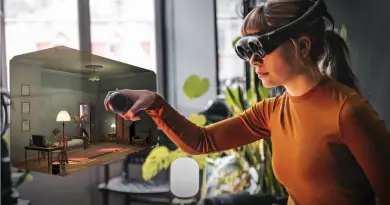The Sophistication of Metaverse Avatars
Metaverse Avatars are evolving entities which are much more than just the fantasies reliever. They are the future of the web as they invite an ocean full of opportunities to the digital world.
Metaverse is in the budding stage, but it offers an enormous range of possibilities to humans and its earthly concerns. The evolution of the Metaverse will give rise to a parallel universe that will co-exist with the real world, and the avatars of humans will reside in that universe. The Metaverse will propose a limitlessly and sans boundary environment. Although the Metaverse is currently limited to virtual worlds and online platforms, with the evolution of augmented reality, it will slowly expand its horizons. Avatars are the presiding technology of the Metaverse because of their infinite capabilities to replicate real-world people and their movements.
Social media is very well amicable with the Avatars. Recently, Facebook announced the future scope of Avatars by initiating new research using VR Technology. Other organizations like Microsoft are also showing interest in user avatars for the Metaverse, and the future has something big for this technology.
Avatar in the Metaverse
“Avatar” originated from the Sanskrit word for “descent”. The descent was usually referred to as the human form deities took when descending to the earth to perform a specific task or duty.
In the world of computers, avatars refer to the digital form of users. They appealed to the world in the ‘80s when internet users and gamers used them. The motive of these avatars was to make users more conscious of the game ethics so that the experience becomes surreal for them. Because when the users saw themselves so precisely and accurately presented on-screen, they connected with the game and internet in a more immersive way.
The same idea and principle now can be experienced on social media platforms as our avatars represent us as who we are in a virtual space or gaming world. The action, decisions, and feelings of one’s avatar are identical to their own. The first example is the use of avatars on Facebook (now Meta) and the second example is the vision of Microsoft to experience a metaverse rich in the latest technologies and lifelike avatars.
Types of Avatars in the Metaverse
Avatars are not only restricted to the representation of the users’ digital identity, but they are also open to display their personality, identity, and likeness. Based on their use in different platforms, there are different types of avatars in the Metaverse:
2D Avatars
2D avatars are the first batch of metaverse avatars. They are 2D-based avatars means picture or pixel-based representations of someone, and are used within 2D environments.
3D Avatars
With the exponential advancement and development in technology, 2D avatars gave rise to a full 3D expression for users. This provides a fully human-like form to a 2D avatar that can be viewed from multiple angles. Here the avatars also included other elements like hair and skin tone that made them lifelike.
Full Body Avatars
As the name signifies, the whole body avatars are the digital representation of the user’s entire body. In these avatars, sensors recreate the whole body’s movements and impressions through a kinematics system. Thus, the user can fully view their avatar and effortlessly move around in a virtual world. The avatars can use all limbs to interact with the other avatars, and the digital assets do the same way an average human can. The areas of their applications include sophisticated VR games. And they may also have a bright future in Meta.
VR Avatars
A VR avatar is a visual representation of a user in a virtual world that they can control. Here, the user sees the world from the avatar’s point of view. VR avatar is usually designed based on the user’s appearance, and they behave as the user acts. Other virtual world users can only see the upper part of the avatar and their arms. These avatars can perform only simple movements like gesturing or turning around. Their legs movement are unwanted and unseen here. The VR avatars can be as accurate as the actual users or more sophisticated and stylized ones used in comic books and video games.
Importance of Avatar in Metaverse
There is no Metaverse without an avatar. An avatar is crucial because it allows you to express your identity in the digital realm, without which the working of a metaverse seems quite impractical. Interoperability is the most vital feature of avatars in Metaverse. Avatars can switch from one project to another and explore different experiences simultaneously, just like humans do in the real world.
For example, it is using an avatar to complete a gaming challenge, earn tokens saved in a wallet service, visit a virtual marketplace, and purchase some things.
Features of Avatars in the Metaverse:
Avatars Are Customisable
The users have complete freedom in customizing their avatars. They can change the height, weight, skin tone, hair color, and even clothing of their avatars. With NFTs comes excellent flexibility as you can buy clothes for your avatar according to your preferences, closer to your personality.
Avatars Are Movable
Metaverse allows avatars to move in the Metaverse and experience different scenarios. The avatars are made up of elements easily recognized by any metaverse instance used by the NFT system. And this facilitates the movement of avatars from one blockchain-based NFT system to another.
Avatars Have Intrinsic Value
Avatars provide basic functioning to the Metaverse. They bring digital goods to life that themselves have value. The avatars can own these goods, thanks to the NFT system.
What Does the Future Hold for Metaverse Avatars?
Metaverse Avatars are evolving entities that are much more than just the fantasies reliever. They are the future of the web as they invite an ocean full of opportunities to the digital world. With the help of avatars, the digital world can reach a new height in the field of development, making the impossible things possible.
Recent Progress Towards Metaverse-Ready Avatars
There are a few advancements in the field of Metaverse that should be acknowledged:
- Meta is working to advance the codex avatars that reconstruct human appearance in the virtual world with high precision accuracy.
- Meta is also working on physics-based avatars to recognize their ability to use wearables that can capture and utilize data on the human anatomy.
- Microsoft is slightly ahead of Meta in terms of research experiments. It is launching its 3D avatar service in the first week of November. This will allow Microsoft team users to create their personalized avatars, which will be visible to other meeting participants, even when the webcam is switched off.
- A company called Ready Player Me is currently working on building cross-platform avatars for the Metaverse.



